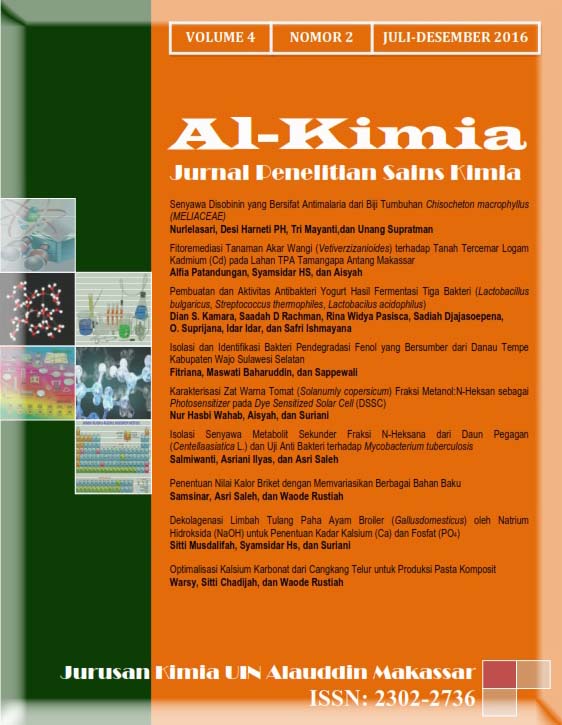Optimalisasi Kalsium Karbonat Dari Cangkang Telur Untuk Produksi Pasta Komposit
Abstract
Egg shell is a household waste which can be used to produce a composite paste, as it contains around 90% calsium carbonate (CaCO3) as the main composition. This research aims to determine the optimum weight of egg shell powder in composite paste production. This research is conducted by determining the calsium carbonate content beforehand by EDTA titration and the determination of the contain of calsium by using atomic absorption spectroscopy (AAS), then the determination of the optimum weight of shell powder by varying the shell powder and baking soda. The results of the research that has been done that the content of calsium carbonate in the shell of eggs was 92,57% and calsium at 28%. While the optimum weight for the shell powder manufacture composite paste which is 3 grams with a ratio of 3,0 (Ca) : 7,0 (BS), in which the pH obtained is 9. This is in a accordance by SNI that the pH value of the composite paste is 4,5–10,5 and is semisolid form.
Downloads
References
Chowdhury, Banani, R., et.al., 2013, Herbal Toothpaste-A Possible Remedy for Oral Cancer,Natural Product, 6: 44-55.
Junaidi, Rido, Syukri Arief, dan Syukri, 2013, Sintesis dan Karakterisasi Komposit yang Berbahan Dasar Kitosan, Silika dan Kalsium Fosfat, Kimia, 2(1): 77-82.
Linardi, Alicia Nadia, 2014, Perbedaan pH Saliva Antara Pengguna Pasta Gigi yang Mengandung Baking Soda dan Pengguna Pasta Gigi yang Mengandung Flour, Skripsi, Makassar: Universitas Hasanuddin Makassar.
Nurlaela, A., et.al., 2014, Pemanfaatan Limbah Cangkang Telur Ayam dan Bebek sebagai Sumber Kalsium untuk Sintesis Mineral Tulang, FPI, 10: 81-85.
SNI 12-3524, 1995, Pasta Gigi, Jakarta: Dewan Standarisasi Nasional.
Sridianti, Pengertian Gliserin dan Kegunaannya, Artikel Kimia, http://Sridianti. Artikel Kimia.htm/2014/06/ Pengertian-Gliseri- dan-Kegunaannya, Html (Diakses11 Mei 2015).
Zulti, Fifia, 2008, Spektroskopi Inframerah, Serapan Atomik, Serapan Sinar Tampak dan Ultraviolet Hidroksiapatit dari Cangkang telur,Skripsi, Bogor: Institut Pertanian Bogor.
Copyright (c) 2016 Al-Kimia

This work is licensed under a Creative Commons Attribution-NonCommercial-ShareAlike 4.0 International License.
Authors who publish with this journal agree to the following terms:
1) Authors retain copyright and grant the journal right of first publication with the work simultaneously licensed under a Creative Commons Attribution License that allows others to share the work with an acknowledgement of the work's authorship and initial publication in this journal.
2) Authors are able to enter into separate, additional contractual arrangements for the non-exclusive distribution of the journal's published version of the work (e.g., post it to an institutional repository or publish it in a book), with an acknowledgement of its initial publication in this journal.
3)Authors are permitted and encouraged to post their work online (e.g., in institutional repositories or on their website) prior to and during the submission process, as it can lead to productive exchanges, as well as earlier and greater citation of published work (See The Effect of Open Access).


